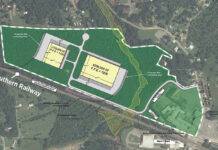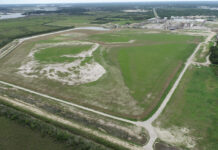Sponsored by
In its heyday, the original Drexel Furniture factory employed hundreds of people. Most were from the North Carolina public power Town of Drexel.
They manufactured furniture for folks in homes and businesses in the U.S. and overseas, including in American embassies and government offices all over the world, according to the “Encyclopedia of North Carolina.”
“It kept our little town alive,” says Drexel Town Manager Sherri Bradshaw. Drexel, a small town of 1,760 is located within a larger metro area of some 366,000 according to U.S. Census data.

When industry changes forced the factory to close in the late 1990s, Drexel residents were left without its crucial support—and with an eyesore of a site, some of which was environmentally contaminated.
For some communities, that would have been the sad end of it. But not for Drexel.
“I know that site’s history and what it has been,” Sherri said.
That means she also knows its potential. So does Alan Wood, President & CEO of Burke Development, Inc., along with representatives from other local organizations who are helping push along the site’s redevelopment.
About seven years and nearly $5 million in grants later, the 100-acre site—these days referred to as the Butler Hill Site—is expected to be ready around mid-2024. With cleanup complete, installing infrastructure, including the Town of Drexel’s electricity, water, sewer, and natural gas services, is underway.

Much of the site is designated an ElectriCities Smart Site, guaranteeing it has met stringent requirements and is ready for industrial permitting.
“It’s the perfect site to do so much and to make such a big difference to Drexel,” Sherri said.
One of its most attractive features? It’s rail served, with the potential for two rail spurs.
That’s a big deal—especially in the North Carolina foothills where topography often makes rail sites rare.
“Rail-served sites are in scarce supply as land availability and development pressures have seen potential rail-served properties taken off the market,” said Joe Stallings, Director of Economic Development at the North Carolina Railroad Company. NCRR has invested $500,000 in redeveloping the Butler Hill Site. “Having a rail-served site in today’s market can be a make-or-break situation for companies, especially those in manufacturing.”
What’s more, Burke County economic developer Alan Wood said, “Once those rail sites are gone, they’re not making any more of them.”
Alan said the redevelopment team’s goal is to take away every conceivable reason a company might have to rule out the site.

“The lead time for industrial projects continues to shrink,” Alan said. “Companies are generally not going to wait for a site to be developed. They want to be permitted and building in six months or less.”
“If you don’t have sites ready to go—have all this due diligence done, have it graded or a grading plan in place, have all your utilities and infrastructure sitting there waiting—there’s no way you can meet those timelines.”
“Redeveloping this site that’s immediately adjacent to Norfolk Southern’s main line is the kind of thing that can revitalize an entire town and a community,” Alan said.
Sherri agrees. “It’s going to be a game-changer for Drexel and for Burke County.”

















![[VIDEO] Get More for Your Business in Ardmore. Oklahoma](https://businessfacilities.com/wp-content/uploads/2024/02/maxresdefault-324x160.jpg)
